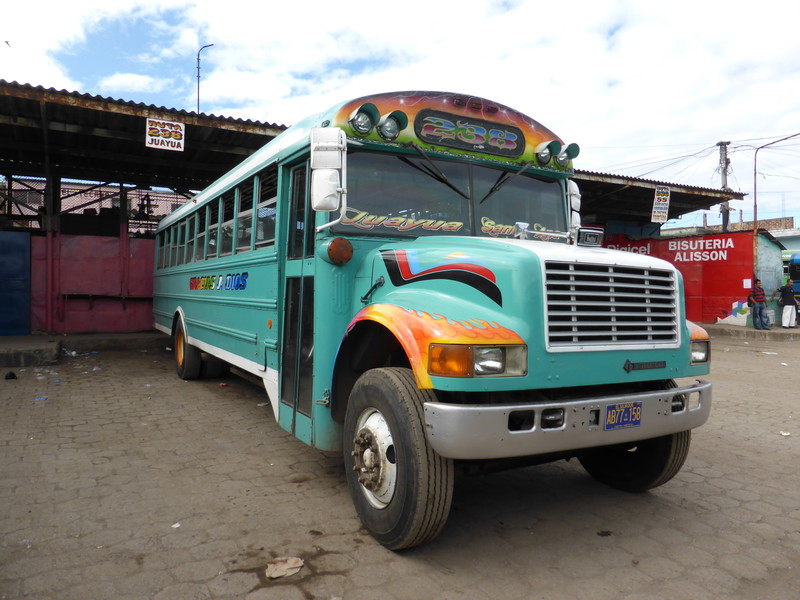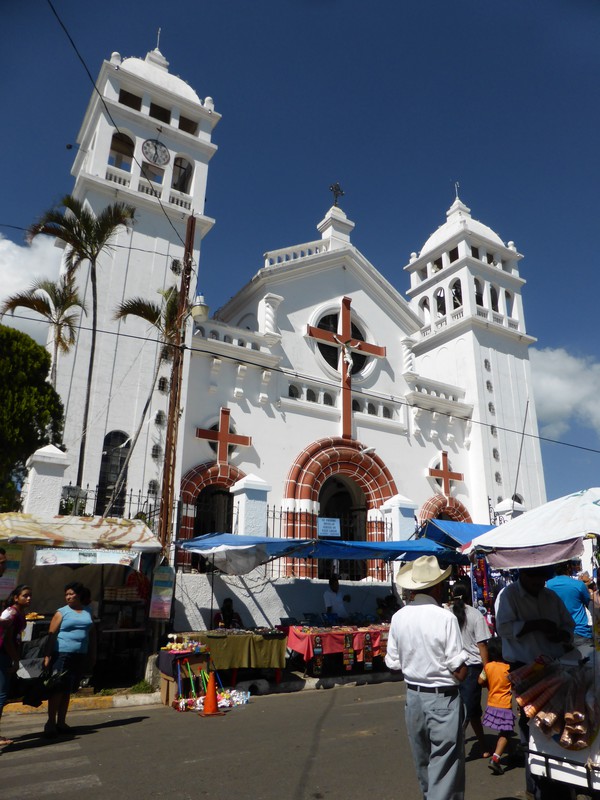
The Ruta de las Flores is a road in eastern El Salvador that's home to pretty towns and villages, coffee plantations, volcanic scenery, lots of greenery, and some of the weirdest food that I've ever eaten. It's a delightful part of the world.
We'd wondered how we were going to tackle the Ruta, because it isn't a single destination and seems tailor-made for visitors with cars. Luckily, it turns out that there's a chicken bus, number 284, that goes up and down the Ruta every ten minutes or so, so all you need to do is get onto the Ruta somehow, and the rest is easy. Carlos, the proprietor at the Casa Verde Hostel in Santa Ana, set us on our way, and the five of us – Peta and I plus Pamela, Matteo and Chris – wandered down to the main bus station in Santa Ana to catch the 9.30am bus to Juayúa (pronounced 'Wha-yoo-wah'), our first destination on the Ruta. The only problem with the main bus station in Santa Ana is that it's in the middle of the market zone, so when the bus eventually left the station at 9.45am, it took a good half an hour to get through the busy stalls and onto the main road, but after some entertaining rattling and bouncing to the ubiquitous 1980s soundtrack, we arrived in Juayúa at 11am, ready for the famous weekend food fair.
Juayúa

Juayúa is a lovely little town with a pretty main plaza and a busy market tucked away in the streets behind the church. The food fair is strung along one side of the plaza and consists of lots of different stalls selling all sorts of enticing food, from steaks and corn on the cob to more exotic fare like whole frogs, though when we asked one man about where we could buy iguana, one of the more infamous foods available at the food fair, he told us that it was no longer available as it's a protected species; they did sell fox, though, which presumably isn't.

The people were very friendly, smiling back at us at every turn, and even the local bare-chested nutter was entertaining and told us he didn't want any money from us, though that was the only part of his bonkers Spanish that we understood. Strangely enough, when we popped into the public toilets off the main plaza, there were two young men in there changing into women's clothing, but with all the smiling going on it all just seemed like the fun of the fair.
As it was a bit early for lunch we settled for a delicious iced coffee, and we sat and watched the fun in the main plaza as people milled around trying out the food and generally having fun. It was a good start to our trip down the Ruta de las Flores, but the best was yet to come.
Ataco

The real deal was further down the road in Ataco, which Carlos had recommended we spend time in as it's a more typical Salvadoran experience than the fairly touristy Juayúa. He was absolutely spot on, and it was well worth the effort of the 40-minute chicken bus ride, via the quiet town of Apaneca and past yet more coffee plantations, volcanoes and fincas.
Ataco is clearly yet to be discovered by western tourism, as we were the only white faces in the whole town. People literally stopped and waved at us, from small children to old women on the backs of trucks, and we were made to feel so welcome it was unreal. The food fair in the main plaza felt a lot bigger, too, though this was perhaps because it was all in one lump, rather than being tucked away down the thinner streets of Juayúa.

We managed to get a table in the busy throng and ordered a plate of typical Salvadoran food from one of the stalls, which consisted of round ball-like sausages, chicken wings, a beef skewer, avocado, rice, tomato salsa and some fairly forgettable tortillas that were like thick, dry pancakes. This was all delicious, but the coup de grâce was when Peta spotted the stand selling frogs and iguanas, so we bought a whole grilled frog and two iguana eggs, while Matteo went for the iguana meat, which he shared around.

Frog is, well, frog, and it tastes a bit like gamey chicken, though this didn't come as much of a surprise, as we live next door to France, where frog's legs are a delicacy. However, I'd never tried frog torso until Ataco; the meat is the same as on the legs, but there's hardly any of it, so it's no surprise that the French stick to the legs.
The iguana eggs, though, were a surprise, as they're delicious; the egg shell is rubbery, like a thin but tough balloon, so you bite a hole in one end and squash the contents into your mouth. The egg itself tastes a bit like the yolk of a duck's egg, and there's no white; if you hard-boiled a duck egg, removed the white, mashed up the yolk with a fork and squished it into a small balloon, then that's pretty much what iguana eggs are like. They're surprisingly good.

As for the iguana meat, it was served in such a strong-tasting green sauce that it was pretty difficult to determine what the meat actually tasted like, but after sucking the sauce off, it turned out to taste... well, a bit meaty, really. The ribs are tiny and like fish bones, and there isn't a lot of meat to be had, but it wasn't at all unpleasant. And luckily, it turns out that iguanas aren't a protected species; it is, in fact, a booming export market in Mexico, El Salvador and Puerto Rico, and in the latter it's being used as a way of controlling the reptile's exploding population. So there's no reason not to get stuck in... and I definitely recommend the eggs.
It was well worth the effort of the long and crowded double chicken bus journey from Ataco to Ahuachapán and on to Santa Ana, where we collapsed into a very welcome rest day at the Casa Verde. Now where else can I get hold of some of those iguana eggs? I wonder...